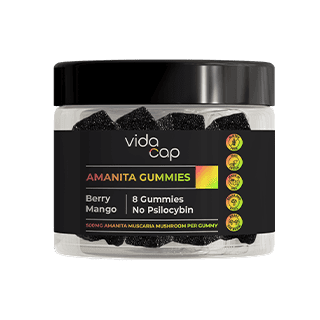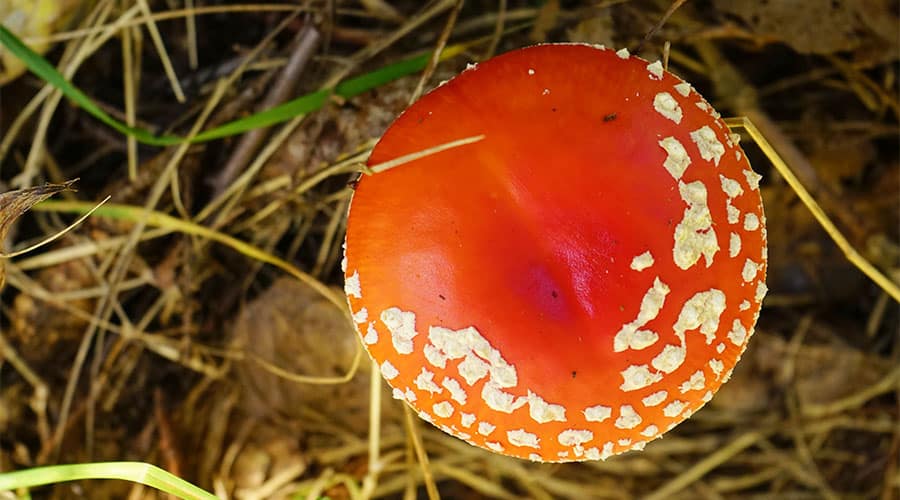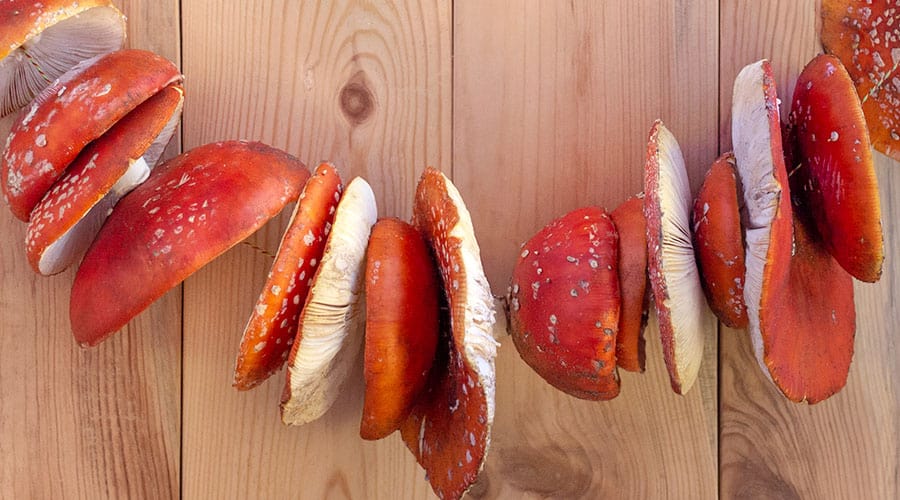If you do enough research into the Amanita muscaria mushroom online, you’ll likely come across contrasting information. On the one hand, it is considered “poisonous” by some people. On the other hand, it is linked with potential medical benefits.
Despite its distinctive appearance, it isn’t a good idea to forage for amanita if you’re not 100% sure what it is. That’s because there’s a risk of mistaking it for mushrooms capable of causing medical emergencies.
Despite the contradictory information, however, most people agree that you should avoid eating Amanita muscaria, also known as the fly agaric, raw. Thus, if you find wild amanita and bring it home, you must know how to prepare it to avoid experiencing unpleasant effects.
This article discusses why you shouldn’t eat amanita raw and looks at cooking options.

If you’re concerned about getting every aspect of amanita preparation right, save yourself the trouble by buying pre-prepared products. VidaCap’s amanita gummies are created using decarbed extract, so you can focus on enjoying the effects.
Why Shouldn’t You Eat Raw Amanita Muscaria?
Suppose you’re walking in the forest one day and come across a pretty mushroom with a red (or orange/yellow) cap and distinctive spots. Yes! You have come across Amanita muscaria. What you DON’T do is bring it home, give it a quick wash, and eat it raw!
Amanita contains a high level of ibotenic acid in its fresh, uncooked state. While this compound is linked with energizing effects, it is also neurotoxic in large doses. There is ample research outlining the negative effects of ibotenic acid.

One study investigated cases where people who consumed certain mushrooms ended up in a regional poison control center. There were 23 cases of Amanita muscaria consumption. Reasons for ingestion included foraging, accidental consumption, and recreational use. Adverse effects included GI upset, central nervous system (CNS) depression, and CNS excitation.
Other side effects can include vomiting, sweating, diarrhea, and headaches. Certainly, the downsides greatly outweigh any possible benefits.
What About Cooked Amanita?
Ancient cultures have used amanita for ritualistic purposes for centuries, if not longer. Indeed, there’s a suggestion that the mushroom is the likely component of soma, a drink consumed by Indo-Aryan cultures in ceremonies for approximately 4,000 years.
In Sanada Town, Japan, rural people view amanita as food and have devised several ways to eliminate the toxic compounds, getting the full benefit without any adverse effects. The residents boil the mushrooms for around 10 minutes and remove the water. In some cases, the process is repeated several times.
Next, they rinse the mushrooms under running water, then pickle them in salt for a month! Finally, they remove the salt by soaking the amanita in water. For most people, this seems like a convoluted process and is unlikely to be adopted by many.
It is also worth noting that these amanita “pickles” are only eaten on special occasions. Furthermore, they are culinary accents rather than forming a substantial part of a meal. Sanada’s youth seem less bothered about continuing the tradition than their ancestors, and the tradition is slowly dying out.
How to Make the Fly Agaric Edible
When analyzing the Amanita muscaria mushroom, you must remember that its primary components are ibotenic acid and muscimol. Remember, ibotenic acid is linked with a number of adverse effects. Granted, there may be some benefits when consumed in very small amounts. In fact, some people deliberately leave ibotenic acid in their amanita to benefit from the energizing effects.
Nonetheless, decarbing amanita mushrooms is how you make them edible. Decarboxylation, to give it its full name, is the process of removing a carboxyl group within a chemical structure. In amanita, this chemical reaction converts the mushroom’s ibotenic acid content into muscimol.
How to Get Amanita Muscaria Ready for Consumption
Drying amanita is one of the quickest ways to eliminate some ibotenic acid but leaves enough to have a noticeable effect.
You’re in luck when you have a dehydrator, as this speeds up the process massively. Set it to around 158 degrees Fahrenheit and let the device get to work for between four and eight hours.
One alternative is to oven-dry your mushrooms at the same temperature. However, this is less effective than a dehydrator and more likely to damage your mushrooms.
Regardless of the drying method, if you have freshly picked amanita, remove dirt using a brush with soft bristles first. Avoid washing them in water, as this will make the mushrooms soggy and interfere with the drying process.
Start Decarbing
If you want to remove as much ibotenic acid as possible, a full decarbing is necessary. Rather than drying them as outlined above, chop the mushrooms and add them to a pot of water. Bring the water to the boil before reducing the heat to a simmer.
The goal is to reduce the water’s pH to between 2.5 and 3.0. Adding lemon juice is an important part of this process. In some quarters, there’s a suggestion to keep the amanita in the water for around three hours. In reality, 30 minutes is enough. At this point, most of the mushrooms’ compounds should be in the water.
You can discard the mushrooms and keep the water. Keep the liquid on low heat for another 150 minutes to fully decarb it. Congratulations! You now have amanita tea.

Another quick method I’ve encountered involves chopping up the amanita and using around seven liters of water for every pound of mushrooms. You also need to add two tablespoons of salt. Put everything into a large pot, put on the lid, and bring the water to the boil.
Now, set a timer for 15 minutes and remove the mushrooms when the time is up. Rinse them thoroughly and dry if you’re planning to saute them. One suggestion is to add some to soup.
Calculating Muscimol Intake
Unfortunately, it is exceedingly tough to decipher how much muscimol is in your newly created tea. You can, however, determine the amount of amanita per liter of liquid.
Suppose you used 200 grams of amanita to create 400ml of liquid. It means there is a gram’s worth of amanita in every 2ml of tea, which is fairly strong! As far as muscimol content, you would require a lab report. One could assume the liquid has a certain % of the compound, but that’s pure guesswork.
As far as dosing is concerned, sampling the smallest possible amount at first is always a good idea. Using the above example, 1 ml of liquid gives you 0.5 grams of amanita. Whether or not this amount has an effect varies from person to person.
You can store your amanita tea in the fridge for a few days. In general, it isn’t smart to try and use it after a week in storage!

If you’re concerned about getting every aspect of amanita preparation right, save yourself the trouble by buying pre-prepared products. VidaCap’s amanita gummies are created using decarbed extract, so you can focus on enjoying the effects.
Final Thoughts on Amanita Muscaria Preparation
In summation, don’t even think about consuming amanita raw. In this state, the mushroom is high in ibotenic acid and will likely cause a cavalcade of adverse effects.
Instead, it is important to decarboxylate the mushroom to transform its ibotenic acid into muscimol. You may find that properly prepared amanita has several positive effects with few side effects.
You also have the option of buying readymade Amanita muscaria products online. However, you should only purchase from reputable sellers that offer updated third-party lab reports. Otherwise, you have no idea what the ibotenic acid or muscimol content is.










